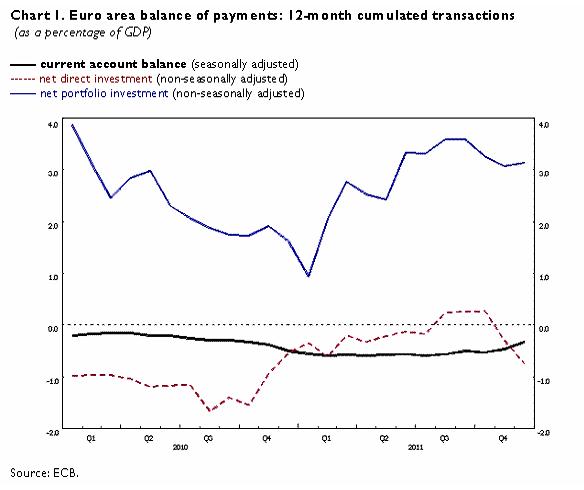Euro area balance of payments in December 2011 and preliminary overall results for 2011 as a whole
In December 2011 the seasonally adjusted current account of the euro area recorded a surplus of €2.0 billion. In the financial account, combined direct and portfolio investment recorded net inflows of €3 billion (non-seasonally adjusted).
In 2011 as a whole, the seasonally adjusted deficit for the euro area current account amounted to €30.6 billion (around 0.3% of GDP), compared with a deficit of €45.7 billion in 2010. Combined direct and portfolio investment recorded net inflows of €224 billion in 2011, compared with net inflows of €98 billion in 2010. This increase was the result of primarily a switch from net purchases to net sales of foreign securities by euro area residents.
Current account
The seasonally adjusted current account of the euro area recorded a surplus of €2.0 billion in December 2011 (see Table 1). This reflected surpluses for goods (€7.3 billion) and services (€4.3 billion), which were partially offset by deficits for current transfers (€8.6 billion) and income (€0.9 billion).
According to the preliminary results for 2011 as a whole, the seasonally adjusted current account recorded a deficit of €30.6 billion (around 0.3% of euro area GDP – see Table 1 and Chart 1), compared with a deficit of €45.7 billion in 2010 (around 0.5% of euro area GDP). The narrowing of the current account deficit resulted from increases in the surpluses for services (from €45.9 billion to €59.4 billion) and income (from €3.0 billion to €9.2 billion), which were partly offset by a decrease in the surplus for goods (from €8.7 billion to €4.1 billion). The deficit for current transfers remained unchanged.

Financial account
In the financial account (see Table 2), combined direct and portfolio investment recorded net inflows of €3 billion in December 2011, reflecting net inflows for both direct and portfolio investment (€1 billion and €2 billion respectively).
In direct investment, net outflows of €4 billion in equity capital and reinvested earnings were more than compensated for by net inflows of €6 billion in other capital (mostly inter-company loans).
The net inflows for portfolio investment resulted from net inflows both for equity (€15 billion) and for bonds and notes (€20 billion), which more than offset net outflows for money market instruments (€33 billion). Developments in money market instruments were characterised by net sales of euro area securities by non-residents (€21 billion) and net purchases of foreign securities by euro area residents (€12 billion).
The financial derivatives account recorded net outflows of €7 billion.
Other investment recorded net outflows of €14 billion, reflecting net outflows for MFIs excluding the Eurosystem (€136 billion), which were partly offset by net inflows for the Eurosystem (€103 billion), other sectors (€18 billion) and general government (€2 billion). The net inflows for the Eurosystem were mainly related to the reciprocal currency arrangements (swap lines) between the European Central Bank (ECB) and central banks outside the euro area.
The Eurosystem’s stock of reserve assets decreased by €16 billion in December 2011 (from €683 billion to €667 billion), mainly on account of a decrease in the market price of gold that was partly offset by net transactions (excluding valuation effects) amounting to €5 billion.
In 2011 as a whole, combined direct and portfolio investment recorded cumulated net inflows of €224 billion, compared with net inflows of €98 billion in 2010. This increase was largely the result of higher net inflows for portfolio investment (increasing from €148 billion to €293 billion), which in turn reflected mainly a switch from net purchases (€146 billion) to net sales (€60 billion) of foreign securities by euro area residents.
Data revisions
This press release incorporates revisions to the data for November 2011. These revisions have not significantly changed the previously published data.
Additional information on the euro area balance of payments and international investment position
In this press release, the seasonally adjusted current account refers to working day and seasonally adjusted data. Data for the financial account are not working day or seasonally adjusted.
In line with the agreed allocation of responsibilities, the European Central Bank compiles and disseminates monthly and quarterly balance of payments statistics for the euro area, whereas the European Commission (Eurostat; see news releases for “Euro-indicators”) focuses on quarterly and annual aggregates for the European Union. These data comply with international standards, particularly those set out in the IMF’s Balance of Payments Manual (fifth edition). The aggregates for the euro area and the European Union are compiled consistently on the basis of transactions and positions vis-à-vis residents of countries outside the euro area and the European Union respectively.
A complete set of updated euro area balance of payments statistics (including a quarterly geographical breakdown for the main counterparts) and international investment position statistics is available in the “Statistics” section of the ECB’s website under the headings “Data services”/“Latest monetary, financial markets and balance of payments statistics”. These data, as well as historical euro area balance of payments time series, can be downloaded from the ECB’s Statistical Data Warehouse (SDW). Data up to December 2011 will also be published in the March 2012 issues of the ECB’s Monthly Bulletin and Statistics Pocket Book. Detailed methodological notes are available on the ECB’s website. The next press release on the euro area monthly balance of payments will be published on 19 March 2012.
Annexes
Table 1: Current account of the euro area
Table 2: Monthly balance of payments of the euro area
Euroopa Keskpank
Avalike suhete peadirektoraat
- Sonnemannstrasse 20
- 60314 Frankfurt am Main, Saksamaa
- +49 69 1344 7455
- media@ecb.europa.eu
Taasesitus on lubatud, kui viidatakse algallikale.
Meediakontaktid

